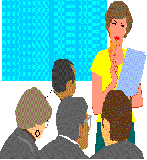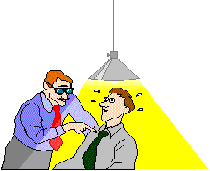|
Preface
For too long we have devoted our training efforts to developing skills that only
enhance opportunities for “not guilty” jury verdicts. This training is needed,
but training directed exclusively or primarily toward this goal is
disproportionate to our predominant task. The Need to Identify Models of Representation Models of Representation Bird's
Eye View of Criminal Justice System We begin this models of representation section by
including here a simplistic, bird's eye view of the criminal justice system. We
then follow these statements about the criminal justice system with a section
that both identifies and explains the various models of
representation.These views about the criminal justice system and models of representation are included to accomplish more than a philosophical discourse; and, certainly, are included to do more than to throw stones at those who work the other side of the street. We include these sections to identify the depth of problems that occur when we assume the responsibility of representing a person accused of a serious crime. Hopefully, by reflecting on these very basic problems, we can expand our vision and imagination about corrective measures that can be accomplished by using the techniques advocated in our paper about Y2K9 Action Motions. There is an urgent need for fresh articulation of age-old problems that affect equality and fairness in our criminal justice system. Frankly, the subject matter of motions filed in most criminal cases is stale, routine, outdated, and, for the most part, the product of knee-jerk, pedestrian, rubber-stamped thinking. Besides, most motions just provide the court with an opportunity to make disparaging remarks to counsel for the accused. Y2K9 Action Motions redirect the accusations of wrongdoing. To present innovative approaches to centuries-old problems, we must drill deeper into the causes of injustices and inequality in the quality of legal representation and deeper into the injustices and inequality in disposition. To drive this point home, let's look at a hypothetical problem. Assume that we are appointed to represent the interest of a bull that is to engage in a bullfight. First, we know that the matador usually is going to prevail in killing the tortured bull after the bull's neck has been stuck with lances, his back pierced with barbed sticks, and his aorta severed by a sword. We also know that the majority of the crowd will cheer the matador. If we were to file motions on behalf of the bull, just what motions would we file? In this example, we clearly know we would attack the fairness of the entire process. Why then do we only make superficial attacks to the process of assigning counsel to indigent persons? Why then do we make only superficial attacks to the conduct of the prosecutor, the judge and law enforcement? Could it be that the business model that brings us into the case restrains us? Let's examine the various business models and hope that this examination will give us subject matter for more innovative, corrective measures -- i.e., motions. Two Main
Categories of Models of Representation It is relevant to identify the models of
representation. First, these models may be placed into two main categories.
One category will identify the methods of compensation for the attorney
representing a client. This main category of models of representation we will
classify as the economic models.The other category of models of representation that we identify will be a classification that relates to the techniques used by the attorney in fulfilling the role of the client's legal representative.
The Economic Models of Representation
This once predominate method of
compensation of attorneys has almost fallen into obscurity in major cases
involving violent crimes. The cost of engaging competent private counsel is out
of financial reach for most persons in the criminal justice system. Persons
with relatively small amounts of financial resources usually attempt to engage
attorneys who offer representation at an affordable price. Often the services
provided by this type of attorney are in keeping with the cheap price.
Naturally, persons with good judgment in engaging counsel and adequate
financial resources step to the head of the line when justice is administered.
Often privately engaged counsel are not compensated adequately to engage
in a sustained attack on the fairness of the entire criminal justice
process.
Attorneys obtained thought this method of
compensation vary greatly as to both competency and commitment to the accused
person. When the government selects the attorney who is to determine if the
government is providing a fair tribunal or if the government is only providing
an arena for a bullfight, there are immense constitutional problems. What
happens to the attorney that attacks the government? Does the attorney receive
full compensation for the time spent on the attack?
Many dedicated attorneys work as public defenders. Do these
attorneys work with a glass ceiling over the attacks that they are
permitted to make against the process of the government?
Many private interest organizations provide invaluable services
to persons who could not have good representation otherwise. Like all of the
various economic models, this model has a great potential for a conflict with
the best interest of the client.
|



